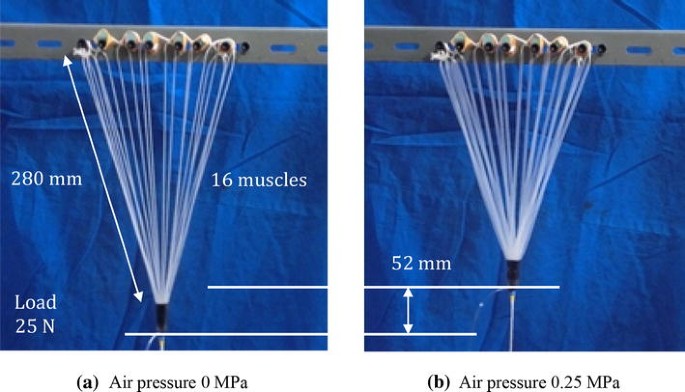Saturday 21:00, 03/12/2022
I'm feeling a little bit better after spending almost a day making Project Log 6, after finishing it I felt like my brain had been deep fried.
So, let's start with the artificial muscles, the multifilament McKibben muscle that I talked about on Project Log 1, you can read their article here.
 1kg is the equivalent to 9 Newton, so 16 muscle-fibers of this multifilament can lift 25 Newton (2.54 Kg), and I would prefer to "translate" 16 fibers = 1 Kg merely for redundancy.
1kg is the equivalent to 9 Newton, so 16 muscle-fibers of this multifilament can lift 25 Newton (2.54 Kg), and I would prefer to "translate" 16 fibers = 1 Kg merely for redundancy.So, every fiber in the picture has 280mm of length (28 cm), so just this contraption uses 448 cm of expandable tubing and expandable braid, 4,4 meters for 1kg (of course, the length of each fiber can be shorter and still lift 1kg).
If I want to lift 1000 tons with an artificial biceps muscle, this means I would need 4,4 Km.
And looking at generic silicon tubing sellers on google, I can only find them selling 5 meters or less in one go.
So the price tag for 1 meter is normally 2-3 Reais (my country's currency, more or less 0,38 dollars), so just for this 1 ton lifting muscle with 4,4 km of tubing, I would be paying 8800 Reais on silicon tubing alone...
Of course, if I contact a supplier, this will maybe get cheaper.
For example, a single purchase on this store from Alibaba of 5000 "units" (1 unit = 1 meter), I would be paying 1000 dollars for 5Km, which is... 5219,40 Reais...
Well, if I need more than 100 muscles, I would need at least 1000 more silicone tubing, which it would probably make it a little more cheaper, but not that much.
Obviously, I can always screw redundancy and cut the value to 2500 Reais (500 dollars) more or less. I'm trying to build redundancy on redundancy, which may not be a good idea.

For comparisson, a hydraulic mechanical jack that can lift 2 ton costs merely 70 brazilian bucks.
And you still could modify these to be electrically operated or accept "hydraulic juice" from another source that isn't the crank shaft.
I wish I could see more information about the weight, internal pressure and things like that, but for some reason no one lists it.
But they weight merely 2 kg (from what the sellers say).
I couldn't find these cylinders being sold without the crank, or cylinders with the same strength.
For some reason they are super ultra expensive, and when they aren't expensive, the shipment fee is around 1000 Reais.
Oh well... I feel like I (like I'm dumb) underestimated the price tag of these kinds of stuff... That's why I'm making this Project log in the first place, because I knew I would be underestimating prices.
Initially I thought the problem was the "Solenoid Creep", and then I thought that artificial muscles would be dirty cheap compared to conventional actuators like electric motors and hydraulic cylinders...
And I don't think I will be able to "just" cut the amount of tubing necessary for 1 ton, because wanting it or not, I will need to lift this much when the entire thing is moving around, walking and running...
Well, I will need to thing in another type of actuator, or another material that can be used to make the artificial muscles.
Or simply use the cheap and readly available hydraulic jack actuators.

(this image is to myself btw)
Why I'm so fixated on artificial muscles?
Anyway, my brain is fried to a krisp, I'm just going to sleep now...
Discussions
Become a Hackaday.io Member
Create an account to leave a comment. Already have an account? Log In.
It's worse than that... with rotating joints, the muscles usually need much higher force because the lever arm between muscle attachment point and fulcrum is much shorter than the length of the bone.
McKibben muscles can be filled with hydraulic fluid instead of air to get more force out of them https://www.youtube.com/watch?v=a6mRhuR_g-E
Fatter tubes will give more force for the same length, and probably use less material than many small tubes. In the end it's just an elaborate method to translate the rotary motion of the motor powering the pump into rotary motion of the joints. Force is proportional to pressure and volume of fluid pumped.
Are you sure? yes | no
"Fatter tubes will give more force for the same length".
I see, I didn't think of that. I will try to find out how to calculate the optimal size.
(Also, that video shows a vectram/kevlar McKibben muscle, I don't think I will have money for that, lol).
Thanks for the advice :)
Are you sure? yes | no